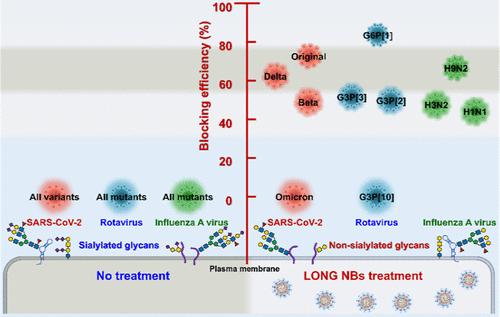Local and Noninvasive Glyco-Virus Checkpoint Nanoblockades Restrict Sialylation for Prolonged Broad-Spectrum Epidemic Virus Therapy
IF 15.8
1区 材料科学
Q1 CHEMISTRY, MULTIDISCIPLINARY
引用次数: 0
Abstract
The coronavirus disease 2019 (COVID-19) pandemic has driven major advances in virus research. The role of glycans in viral infection has been revealed, with research demonstrating that terminal sialic acids are key receptors during viral attachment and infection into host cells. However, there is an urgent demand for universal tools to study the mechanism of sialic acids in viral infections, as well as to develop therapeutic agents against epidemic viruses through the downregulation of terminal sialic acid residues on glycans acting as a glyco-virus checkpoint to accelerate virus clearance. In this study, we developed a robust sialic acids blockade tool termed local and noninvasive glyco-virus checkpoint nanoblockades (LONG NBs), which blocked cell surface sialic acids by endogenously and continuously inhibiting the de novo sialic acids biosynthesis pathway. Furthermore, LONG NBs could accurately characterize the sialic acid-dependent profiles of multiple virus variants and protected the host against partial SARS-CoV-2, rotavirus, and influenza A virus infections after local and noninvasive administration. Our results suggest that LONG NBs represent a promising tool to facilitate in-depth research on the mechanism of viral infection, and serve as a broad-spectrum protectant against existing and emerging viral variants via glyco-virus checkpoint blockade.

局部和非侵入性糖化病毒检查点纳米嵌体可限制 Sialylation,从而实现长效广谱流行性病毒疗法
冠状病毒病 2019(COVID-19)大流行推动了病毒研究的重大进展。聚糖在病毒感染中的作用已被揭示,研究表明末端的硅酸是病毒附着和感染宿主细胞过程中的关键受体。然而,目前迫切需要通用工具来研究病毒感染中的硅酸机制,以及通过下调作为糖病毒检查点的聚糖上的末端硅酸残基来加速病毒清除,从而开发针对流行性病毒的治疗药物。在这项研究中,我们开发了一种稳健的硅铝酸阻断工具,称为局部和非侵入性糖病毒检查点纳米阻断剂(LONG NBs),它通过内源性持续抑制硅铝酸的新生生物合成途径来阻断细胞表面的硅铝酸。此外,LONG NBs 还能准确描述多种病毒变体的唾液酸依赖性特征,并在局部和非侵入性给药后保护宿主免受部分 SARS-CoV-2、轮状病毒和甲型流感病毒感染。我们的研究结果表明,LONG NBs 是一种很有前途的工具,有助于深入研究病毒感染的机理,并可通过糖病毒检查点阻断作用作为一种广谱保护剂,抵御现有的和新出现的病毒变种。
本文章由计算机程序翻译,如有差异,请以英文原文为准。
求助全文
约1分钟内获得全文
求助全文
来源期刊

ACS Nano
工程技术-材料科学:综合
CiteScore
26.00
自引率
4.10%
发文量
1627
审稿时长
1.7 months
期刊介绍:
ACS Nano, published monthly, serves as an international forum for comprehensive articles on nanoscience and nanotechnology research at the intersections of chemistry, biology, materials science, physics, and engineering. The journal fosters communication among scientists in these communities, facilitating collaboration, new research opportunities, and advancements through discoveries. ACS Nano covers synthesis, assembly, characterization, theory, and simulation of nanostructures, nanobiotechnology, nanofabrication, methods and tools for nanoscience and nanotechnology, and self- and directed-assembly. Alongside original research articles, it offers thorough reviews, perspectives on cutting-edge research, and discussions envisioning the future of nanoscience and nanotechnology.
文献相关原料
公司名称
产品信息
索莱宝
base culture medium
索莱宝
DAPI
索莱宝
HRP-conjugated secondary antibody
索莱宝
RIPA lysis buffer
索莱宝
Triton X-100
 求助内容:
求助内容: 应助结果提醒方式:
应助结果提醒方式:


